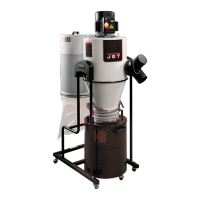11
Improper connection of the
equipment-grounding conductor can result in a
risk of electric shock. Check with a qualified
electrician or service person if you are in doubt
as to whether the outlet is properly grounded.
Do not modify the plug provided with the
appliance – if it will not fit the outlet, have a
proper outlet installed by a qualified electrician.
The conductor with insulation having an outer
surface that is green with or without yellow stripes is
the equipment-grounding conductor. If repair or
replacement of the electric cord or plug is
necessary, do not connect the equipment-grounding
conductor to a live terminal.
Use only 3-wire extension cords that have 3-prong
grounding plugs and 3-pole receptacles that accept
the tool's plug.
Repair or replace damaged or worn cord
immediately.
1. Grounded, cord-connected appliances rated less
than 15 A and intended for use on a nominal 120-V
supply circuit:
This appliance is for use on a nominal 120-V circuit,
and has a grounded plug that looks like the plug
illustrated in sketch A in Figure 15. A temporary
adaptor that looks like the adaptor illustrated in
sketches B and C may be used to connect this plug
to a 2-pole receptacle as shown in sketch B if a
properly grounded outlet is not available. The
temporary adaptor should be used only until a
properly grounded outlet (sketch A) can be installed
by a qualified electrician. The green colored rigid
ear, lug, or the like extending from the adaptor must
be connected to a permanent ground such as a
properly grounded outlet box cover. Whenever the
adaptor is used, it must be held in place by a metal
screw.
In Canada, the use of a temporary adaptor is not
permitted by the Canadian Electrical Code, C22.1.
Figure 15
6.2 Extension cords
The use of extension cords is discouraged; try to
position machines near the power source. If an
extension cord is necessary, make sure it is in good
condition. When using an extension cord, be sure to
use one heavy enough to carry the current your
product will draw. An undersized cord will cause a
drop in line voltage resulting in loss of power and
overheating. Table 1 shows correct size to use
depending on cord length and nameplate ampere
rating. If in doubt, use the next heavier gauge. The
smaller the gauge number, the heavier the cord.
Ampere
Rating
Volts
Total length of
cord in feet
More
Than
Not
More
Than
120
240
25
50
50
100
100
200
150
300
AWG
0 6 18 16 16 14
6 10 18 16 14 12
10 12 16 16 14 12
12 16 14 12
Not
Recommended
Table 1: Extension cord recommendations
7.0 Operations
7.1 Switches
Main power switch (A, Figure 16) – Pull up paddle
switch to engage electrical power to dust collector,
push down to cut off power. Note: The switch must
be in ON position for remote controller to operate.
The safety key (B, Figure 16) can be removed to
prevent unauthorized use of dust collector. Key
must be reinserted to start machine – press until it
snaps back in.
Start/stop button (C, Figure 16) – Turns dust
collector on and off, if remote controller is not used.
Figure 16

